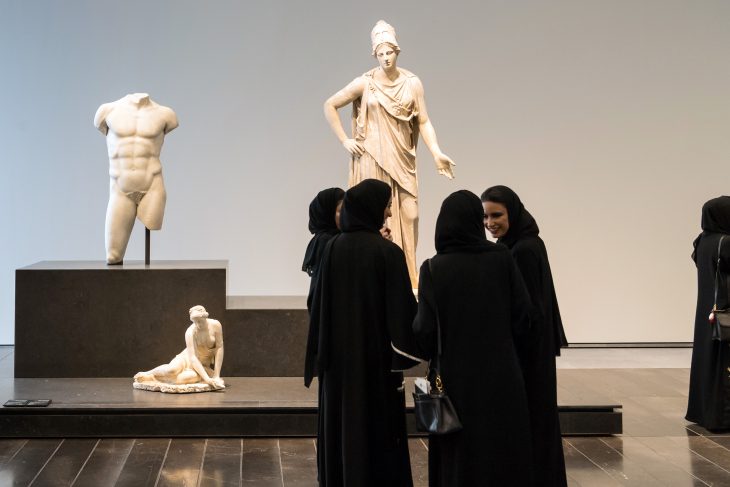The headlines announcing the opening of the dome-shaped Louvre Abu Dhabi are a cornucopia of superlatives. ‘Spectacular palace of culture shimmers in the desert’ and ‘a cultural cornerstone where East meets West’ were two of the most laudatory. ‘East meets West’ is the frequently used cliché. However the new museum, which cost around $1 billion to construct over ten years and is a centrepiece of Abu Dhabi’s attempt to position itself as a cultural hub in the Middle East, is not an example of East meeting West, it is symbol of the post-EastWest era we live in.
French President Emmanuel Macron flew in for the grand opening of the 55-room art collection on 8 November. The agreement to export the Louvre brand to the Gulf was signed in 2007 between the UAE and France and the museum’s website boasts that it is ‘the first universal museum in the Arab world’. It palls in comparison to the original, with 620 pieces of art on display compared to an estimated 35,000 in Paris. Visits are expected to last a few hours rather than the days you might spend in the City of Light poking around the various wings of the palace that became the Louvre in 1793.
Everything about the Louvre Abu Dhabi reminds us of the positives and negatives of the globalized world we live in. It was built mostly by foreign labor imported from countries such as Pakistan and India. Human Rights Watch in 2015 urged the French government to address concerns related to ‘recruitment fees, non-payment of wages, passport confiscation and the creation of a compensation scheme’. Stories of the ill-treatment of workers would not have shocked the Italian sculpture Michelangelo whose 16th century ‘Rebellious Slave’ was made for Pope Julius II but now stands in the Louvre in Paris. The city-states of the Italian Renaissance had many things in common with today’s Gulf States and the attempts by their newly wealthy rulers to buy up art and brand names is akin to purchasing a McDonald’s franchise today. The blending of religion with what is ostensibly a museum about the freedom that comes with artistic expression would have been at home in the Europe that produced the original Louvre.
Macron says that the new Louvre fights against the ‘discourses of hatred’. These discourses of hatred have united East and West, like the globalization that brought the Louvre and architect Jean Nouvel’s design to the Middle East. The recent attacks in Europe and the thousands of extremists who went to join Islamic State are as much symbols of the post-EastWest era as the museum. At a time when ISIS has been defeated only after it destroyed numerous UNESCO sites in Iraq and Syria, can its destructive evil be replaced by importing art? The nihilism of jihadists and their zeal to destroy architecture and art as they did in Mosul, blowing up the 800-year-old al-Nuri mosque in June, bookends 16 year of destruction, beginning with the Taliban’s dynamiting of the Bamiyan Buddhas in 2001.
At the same time as history has been destroyed in the Middle East, many students in the West no longer are familiar with ‘Western civilization’. Niall Ferguson claimed in 2011 that ‘most British teenagers now leave secondary school knowing only unconnected fragments of Western history’. Similarly, a study by the National Association of Scholars in the United States found that none of the top 50 colleges and only one of the 75 public universities mandated ‘Western civilization’ as a course and it had ‘almost disappeared’ as a requirement in other institutions.
East can’t meet West in this environment. Western culture is increasingly unsure of itself, vague in its values and skin deep in its pretensions. The East, insofar as the oil city-states of the Gulf represent ‘the East’ seeks to buy up Western brands, from the Guggenheim to the Louvre and give itself an instant imprimatur of being a cultural meeting place. But the real revolution of the Louvre Abu Dhabi is that there are no cultures meeting there, it has created a new culture of EastWest. In the long term that may be a positive development, since both the pre-existing cultures of the East and West are searching for their footing.






Comments